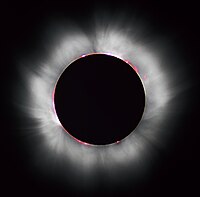
Photo from wikipedia
We present observations from 11 very low frequency (VLF)/low-frequency (LF) receivers across the continental United States during the 21 August 2017 “Great American Solar Eclipse.” All receivers detected transmissions from… Click to show full abstract
We present observations from 11 very low frequency (VLF)/low-frequency (LF) receivers across the continental United States during the 21 August 2017 “Great American Solar Eclipse.” All receivers detected transmissions from VLF/LF beacons below 50 kHz, while seven also recorded LF beacons above 50 kHz, yielding dozens of individual transmitter-receiver radio links. Our observations show two separable superimposed signatures: (1) a gradual rise and fall in signal levels visible on almost all paths as the eclipse advances and then declines, as VLF attenuation is reduced by the changing ionosphere under an eclipsed Sun, and (2) direct reflective scattering off the narrow 100-km-wide totality spot, observed more uniquely when the transmitter or receiver, if not both, are relatively close to the totality spot. Plain Language Summary A solar eclipse provides a unique opportunity to study a region of the upper atmosphere known as the ionosphere, which is essentially the transition zone between Earth’s atmosphere and the space environment. While the Sun is known to have a dominant impact on the electrical properties of this region, it is difficult to quantify it precisely since these altitudes, 60–90 km, are too high to reach with balloons yet too low for satellites. On the other hand, the lower ionosphere plays a key role in communications and navigation. Very low frequency/low-frequency radio waves at 3–300 kHz reflect from this region, thus allowing us to remotely diagnose the lower ionosphere. A solar eclipse is the only time when the Sun’s influence rapidly turns off over a very small region. In this paper, we have analyzed dozens of diagnostic observations, namely, transmitter-to-receiver communications links, that allow to quantify how the lower ionosphere responded to this unique geophysical event. As the Sun’s influence changes, so too does the characteristics of these very low frequency/low-frequency transmitters detected many hundreds to thousands of miles away.
Journal Title: Geophysical Research Letters
Year Published: 2018
Link to full text (if available)
Share on Social Media: Sign Up to like & get
recommendations!